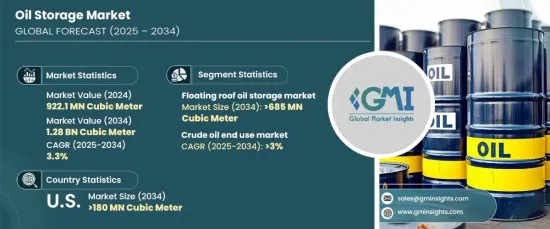
세계의 석유 저장 시장은 2024년 9억 2,210만 입방미터에 달했으며, 2025년부터 2034년에 걸쳐 CAGR 3.3%의 안정적인 성장률을 나타낼 것으로 예측됩니다.
전 세계 에너지 수요가 큰 변화를 겪으면서 지정학적 변화와 저장 기술 혁신 등 다양한 요인으로 인해 석유 저장 환경이 재편되고 있습니다. 이 시장의 주요 촉진요인 중 하나는 휘발유, 경유, 제트 연료와 같은 정제 석유 제품의 소비 증가에 따른 저장 수요의 증가입니다. 특히 급속한 산업화와 도시화가 진행되고 있는 지역에서는 효율적인 저장 솔루션에 대한 수요가 증가하고 있습니다. 이러한 수요와 함께 에너지 자원을 확보하고 가격 변동을 관리하기 위해 전략 석유 비축에 대한 정부의 투자가 증가하고 있습니다.

재생 에너지 통합이 탄력을 받으면서 적응력 있고 효율적인 저장 솔루션의 필요성이 더욱 중요해지고 있습니다. 전략적 석유 비축량이 확대되고 있고 각국은 에너지 안보를 우선시하며 인프라에 대한 투자를 늘리고 있습니다. 특히 아시아태평양 지역의 신흥 경제국들은 에너지 미래를 확보하기 위해 저장 용량을 늘리고 있습니다. 이러한 요인으로 인해 지정학적 변화와 수요 변동에 대응하기 위해 저장 인프라를 강화하는 데 전 세계적으로 관심이 높아지고 있습니다.
부유식 탱크 부문은 2034년까지 6억 8,500만 입방미터 이상에 달할 것으로 예상됩니다. 이 탱크 유형은 환경에 미치는 영향을 줄이고 증발 손실을 최소화하는 능력으로 인해 점점 더 선호되고 있습니다. 이 탱크는 특히 원유 및 정제 석유 제품과 같은 휘발성 액체를 저장하는 데 적합하며, 운영 효율성과 환경 표준 준수를 향상시키는 씰 및 재료의 발전으로 이점을 누릴 수 있습니다. 부유식 루프 탱크는 환경 문제를 완화하고 전반적인 저장 능력을 개선하는 데 중요한 역할을 할 것으로 기대됩니다.
원유 저장 시장은 2034년까지 연평균 3% 이상의 성장률을 보일 것으로 예상됩니다. 이 부문은 변동하는 생산 수준과 다양한 수요 주기에 의해 주도되는 시장의 필수적인 측면으로 남아 있습니다. 인프라 업그레이드는 스토리지 용량을 늘리는 데 도움이 되고 있으며, 모니터링 기술의 발전은 안전성과 효율성을 높이고 더 엄격한 환경 규정을 준수하도록 보장하고 있습니다. 이러한 개선은 석유 저장 산업이 운영 및 환경 문제를 모두 해결하는 데 필수적입니다.
미국의 석유 저장 시장은 2034년까지 1억 8천만 입방미터를 넘어설 것으로 예상됩니다. 미국의 탄탄한 셰일 생산과 수출 활동의 증가는 저장 수요에 중추적인 역할을 하고 있습니다. 전략적 석유 비축량과 민간 저장 시설의 확장은 시장 변동을 관리하면서 증가하는 생산량을 수용하는 데 초점을 맞추고 있습니다. 이러한 요인들이 시장 역학을 강화하여 미국이 글로벌 석유 저장 부문의 핵심 플레이어로 자리매김하고 있습니다.
The Global Oil Storage Market reached 922.1 million cubic meters in 2024 and is projected to experience a steady growth rate of 3.3% CAGR from 2025 to 2034. As global energy demand undergoes significant changes, various factors, including geopolitical shifts and technological innovations in storage, are reshaping the landscape of oil storage. One major driver for this market is the increasing need for storage to accommodate the growing consumption of refined petroleum products such as gasoline, diesel, and jet fuel. Particularly in regions that are undergoing rapid industrialization and urbanization, the demand for efficient storage solutions is on the rise. In tandem with this demand is the rise in government investments in strategic petroleum reserves, aimed at securing energy resources and managing price fluctuations.

As renewable energy integration gains momentum, the need for adaptable and efficient storage solutions is becoming even more critical. Strategic petroleum reserves are expanding, and nations are prioritizing energy security, driving investments in infrastructure. Emerging economies, particularly in Asia-Pacific, are stepping up their storage capacities to secure their energy futures. These factors are contributing to a growing global focus on boosting storage infrastructure to address geopolitical changes and demand fluctuations.
The floating roof tank segment is projected to reach over 685 million cubic meters by 2034. This tank type is becoming increasingly favored due to its ability to reduce environmental impact and minimize evaporation losses. These tanks are particularly suited for storing volatile liquids such as crude oil and refined petroleum products, benefiting from advancements in seals and materials that enhance operational efficiency and compliance with environmental standards. The floating roof tanks are expected to play a crucial role in mitigating environmental concerns and improving overall storage capabilities.
The market for crude oil storage is anticipated to grow at a rate of over 3% CAGR by 2034. This segment remains an essential aspect of the market, driven by fluctuating production levels and varying demand cycles. Upgrades to infrastructure are helping to increase storage capacity, and advancements in monitoring technologies are ensuring greater safety, efficiency, and adherence to stricter environmental regulations. These improvements are vital for the oil storage industry to meet both operational and environmental challenges.
The U.S. oil storage market is projected to surpass 180 million cubic meters by 2034. The country's robust shale production, coupled with growing export activities, plays a pivotal role in the demand for storage. Expansions in strategic petroleum reserves and private storage facilities are focusing on accommodating the rising output while managing market fluctuations. These factors are enhancing the market dynamics, positioning the U.S. as a key player in the global oil storage sector.